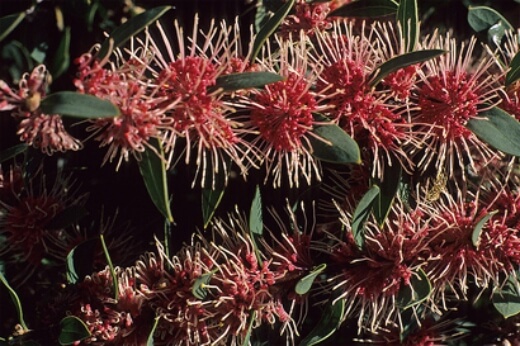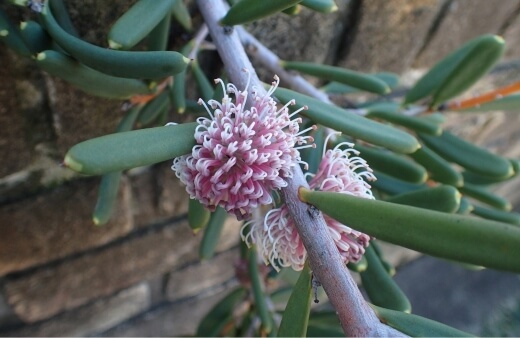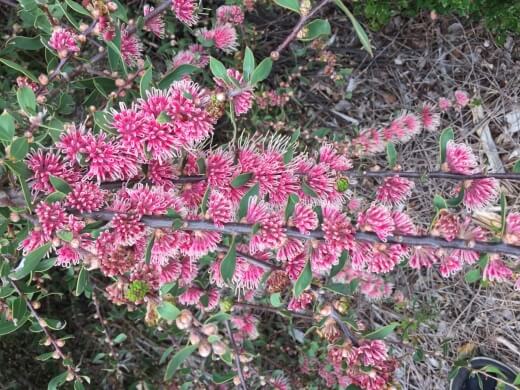Hakeas are popular Australian natives that offer beautiful blooms that will attract a wide range of nectar-feeding birds to your garden. One of the most curious cultivars of the Hakea species is the Hakea ‘Burrendong Beauty’.
An exciting hybrid of the species, the Hakea ‘Burrendong Beauty’ has marvellous, pin-cushion-like blooms. Here is how to cultivate, care for and grow the Hakea ‘Burrendong Beauty’.
More...
Introducing Hakea ‘Burrendong Beauty’
Family: Proteaceae
Genus: Hakea
Species: Hybrid of H.myrtoides and H.petiolaris
Common Name: 'Burrendong Beauty'
Flower Colour: Pink/red
Foliage Colour: Dark Green
Growth Habit: Shrub to 1.5m
Flowering: Winter

Source: Apsmorningtonpeninsula.org
Hakeas are part of the Proteaceae family, a very popular and sought after species throughout Australia. The Burrendong beauty is a cultivated hybrid of the Hakea myrtoides and Hakea petiolaris.
It’s a low-spreading shrub, with evergreen foliage and spectacular flowers which bloom into a deep pink colour. As with most Hakea species, the blooms grow into a round, pin-cushion like a ball with long white tubular growths around it.
Although this cultivar only ever grows around 0.5 to 1.5 metres high, its spread is often over 3 metres. This makes it a great landscaping plant to grow as a border plant or ground cover.
Best suited for low humidity areas, this cultivar begins its bloom during the autumn and will produce a dramatic, floral spectacle in the winter.
Growing Hakea ‘Burrendong Beauty’

Even when given a few basic conditions, the burrendong beauty blooms quite extensively. However, good drainage and low humidity will be essential.
Although this cultivar can be grown in a pot or the ground, it is best suited for outdoor growth. Unless grown in an extremely sunny spot in a home, it is incredibly unlikely to flower.
As such, it is best to pick a sunny spot in your garden that gets a good amount of airflow. Around 6 hours of direct sunlight per day is ideal for a bountiful bloom.
Unfortunately, humidity can be an issue for this cultivar, so it’s not a great choice for coastal areas, or anywhere that experiences an extremely humid summer. Excessive humidity can cause dieback, which would be fatal for your plant.
As such, it’s also important to choose loose, well-draining soil. Sandy or loam soils are a great option. If planning on growing in clay soils, you will need to prepare the soil before planting.
If growing your burrendong beauty in a slightly windier spot, it may be advisable to stake the base stem during the first few years of growth.


Get Your Free Guide:
Master Growing Australian Natives eBook
A Must Have Complete Guide for Every Australian Garden
Get Your Free Guide:
Master Growing Australian Natives eBook
A Must Have Complete Guide for Every Australian Garden
Planting Hakea ‘Burrendong Beauty’
For growers who don’t have the patience to grow burrendong beauty from seed, this cultivar can be found at certain native plant nurseries.
When planting, you’ll need to:
- Pick a spot for planting and supplement the soil with a slow-release granular fertiliser.
- Dig a hole twice the size of the root ball, which is approximately the same depth as the pot in which it had been growing.
- Remove the root ball from the pot, gently tousling the roots loose.
- Place the root ball into the hole, ensuring the top of the root ball lines up to the ground level.
- Backfill with soil and gently pat down with your hands.
How to Propagate Hakea ‘Burrendong Beauty’

Most Hakea species can be cultivated using three methods: by seed, by cutting or from grafting. Although, grafting can be incredible when not experienced with this hybrid. As such, propagating by seed or cutting is advised for beginner growers.
Growing Hakea ‘Burrendong Beauty’ from Seed
Seeds can be removed from plants a few months after flowering. Once removed from the plant, seed pods usually split within a week (or so) to reveal two small, winged seeds. However, these usually require excessive heat in order to do so.
Here is the fastest way to get your seeds to grow:
- Cook seeds after picking. Heat seeds in an oven at 120°C for about an hour. This will cause the seed pods to split, and seeds can be removed using a pair of tweezers.
- Plant seeds. Sow seeds onto the surface of a porous, seeding mix in a seeding tray.
- Keep seeds moist. After planting, it is advised to soak the soil, allowing the seeds to lodge. Thereafter, simply mist the soil to keep the seeds moist but not wet.
Germination usually takes 14 to 60 days. Seedlings can be replanted once new growth appears.
Growing Burrendong Beauty from Cuttings
Getting cuttings to grow can also be incredibly tricky. However, it is possible. Cuttings should only be taken from healthy, thriving parent plants. Take care not to remove any diseased or damaged parts of the plant.
You’ll want to:
- Remove the cutting. Take a cutting around 75-100mm using a sharp blade. The cutting should have at least 5 to 6 young, healthy leaves.
- Remove lower leaves. Remove leaves around the lower part of the cuttings, leaving only a few healthy leaves at the top.
- Wound the lower stem. Wounding will help to promote root growth. Using a sharp blade, make a few small incisions at the base of the stem.
- Dip into rooting hormone. A rooting hormone will help to speed up the root growth process. Simply dip the wounded end into a rooting hormone for about 30 seconds.
Plant your cutting. Plant your cutting into a small pot with a rich soil mixture. Keep your cutting in a warm, sunny spot to root.
Hakea ‘Burrendong Beauty’ Care Guide

Source: Apsmorningtonpeninsula.org
Luckily, once you’ve started growing Hakea ‘Burrendong Beauty’ , it won’t require too much additional care. Your burrendong beauty will only require water when the soil is completely dry.
Avoid overwatering at all costs, as this often leads to root rot or other fungal issues. Occasionally check the soil. When the first 5 cm are completely dried out, you can consider soaking the soil.
Although it’s not always necessary, a native plant fertiliser can be added to the soil to support your plant and promote a brighter bloom.
Fertiliser can be added once annually during the summer, ahead of the blooming season in autumn. Learn more on which fertiliser would best work for you in our complete guide on garden fertilisers.
As with other Hakea species, pruning can be done to regulate shape and size or to remove any spent blooms after the blooming season. This hybrid does not respond well to harsh pruning. As such, avoid cutting back too much old growth.
Common Burrendong Beauty Problems
There are not often issues with this cultivar, provided it’s growing in a low-humidity area and in well-draining soil. When experiencing too much moisture, this cultivar tends to develop fungal diseases or dieback, which can be fatal for your plant.
As long as you are regulating your watering and keeping your burrendong beauty in a spot with sufficient airflow, you shouldn’t have an issue.
Hakea ‘Burrendong Beauty’ Frequently Asked Questions
Is Hakea ‘Burrendong Beauty’ cold hardy?
Hakea ‘Burrendong Beauty’ is a half-hardy shrub that can cope with freezing temperatures down to -5 for short spells. In prolonged frost, Hakea ‘Burrendong Beauty’ will need protection from snow and ice, but garden fleece is enough protection for most cold parts of Australia.
Is Hakea ‘Burrendong Beauty’ an Australian native?
Hakea ‘Burrendong Beauty’ is not a native plant, but its parents are true Austrian natives. Hakea ‘Burrendong Beauty’ is a garden cultivar, bred selectively for horticulture and landscape design use, and is not present in the wild.
How tall does Hakea ‘Burrendong Beauty’ grow?
Hakea ‘Burrendong Beauty’ grows to a maximum of 1.5m tall after 10-15 years. This particular Hakea is grown as a low-growing evergreen shrub so its spread is more impactful than its height. Many gardeners choose to prune Hakea ‘Burrendong Beauty’ to no more than 1m tall to create a stunning ground cover plant.
Is Hakea ‘Burrendong Beauty’ low maintenance?
Hakea ‘Burrendong Beauty’ is incredibly low maintenance. For the first year, it will need good irrigation to help roots to establish, but beyond that, it is drought tolerant, reasonably cold hardy, and requires little to no maintenance, especially if you’re prepared to let it grow to its full potential.
How wide does Hakea ‘Burrendong Beauty’ spread?
Hakea ‘Burrendong Beauty’ spreads to about 3m wide making it a great ground cover plant for gardeners and landscape designers who need to fill large spaces on a budget.
How quickly does Hakea ‘Burrendong Beauty’ spread?
Hakea ‘Burrendong Beauty’ is slow growing, won’t reach its final spread for around 20-30 years, and will continue maturing, developing hardier stems, and bushing out until it is at least 50 years old.
Is Hakea ‘Burrendong Beauty’ invasive?
Hakea ‘Burrendong Beauty’ is not invasive, and will not easily self-seed in the garden. In most cases it will need active propagation to create new plants, so remains fairly self-contained. The roots of Hakea ‘Burrendong Beauty’ are tough, but as a low-growing variety it can be planted reasonably close to structures without causing any damage.
Is Hakea ‘Burrendong Beauty’ toxic to pets?
Hakea ‘Burrendong Beauty’, like all hakeas can cause skin irritation, and if ingested, potential gastrointestinal distress, but it is not considered toxic, and is generally safe to have around pets and children.
Is Hakea ‘Burrendong Beauty’ edible?
While it’s not strictly toxic, Hakea ‘Burrendong Beauty’ is also not edible. It can cause stomach upsets and provide little to no flavour as a foodstuff. Despite its similarity to Australian Honeysuckle, it’s definitely worth steering clear of eating any part of this plant.
When does Hakea ‘Burrendong Beauty’ flower?
Hakea ‘Burrendong Beauty’ flowers in winter, but with deadheading can continue well into Spring. Its vivid red flowers begin as small buds and stretch out into stems rammed full of dangling tails of crimson.
What does Hakea ‘Burrendong Beauty’ smell like?
Hakea ‘Burrendong Beauty’ doesn’t have a particularly strong fragrance, but on warm winter days, it’s nice to have it near a patio for a light waft of its sweet, slightly spicy aroma.
Does Hakea ‘Burrendong Beauty’ attract insects?
Hakea ‘Burrendong Beauty’ is a great way to bring bees and other pollinating insects into the garden, and is especially attractive to wasps, which can help to manage pest insects too.

Start Growing Hakea ‘Burrendong Beauty’ Today!
If you’re considering growing some other hakea plants in your garden? Take a look at our other Hakea guides here:
At the end of the day, the Hakea ‘Burrendong Beauty’ is a great option for Australian gardens. It’s easy to care for and fairly easy to grow; you’ll have a fantastic feature plant that blooms in the winter and invites a range of wildlife to your garden.
Published on January 17, 2023 by Gary Clarke
Last Updated on February 22, 2024




